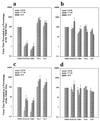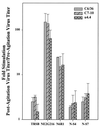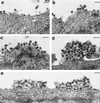The host range phenotype displayed by a Sindbis virus glycoprotein variant results from virion aggregation and retention on the surface of mosquito cells
- PMID: 11070041
- PMCID: PMC113246
- DOI: 10.1128/jvi.74.23.11398-11406.2000
The host range phenotype displayed by a Sindbis virus glycoprotein variant results from virion aggregation and retention on the surface of mosquito cells
Abstract
The Sindbis virus variant NE2G216 is a PE2-containing host range mutant that is growth restricted in cultured mosquito cells (C6/36) due to inefficient release of virions from this cell type. The maturation defect of NE2G216 has been linked to the structures of N-linked oligosaccharides synthesized by arthropod cells. Analysis of C6/36 cells infected with NE2G216 by transmission electron microscopy revealed the presence of dense virus aggregates within cytoplasmic vacuoles and virus aggregates adhered to the cell surface. The virus aggregation phenotype of NE2G216 was reproduced in vertebrate cells (Pro-5) by the addition of 1-deoxymannojirimycin, an inhibitor of carbohydrate processing which limits the processing of N-linked oligosaccharides to structures that are structurally similar, albeit not identical, to those synthesized in C6/36 cells. We conclude that defective maturation of NE2G216 in mosquito cells is due to virion aggregation and retention on the cell surface and that this phenotype is directly linked to the carbohydrate-processing properties of these cells.
Figures






Similar articles
-
Linkage of an alphavirus host-range restriction to the carbohydrate-processing phenotypes of the host cell.J Gen Virol. 2000 Jan;81(Pt 1):161-70. doi: 10.1099/0022-1317-81-1-161. J Gen Virol. 2000. PMID: 10640554
-
Differential processing of sindbis virus glycoprotein PE2 in cultured vertebrate and arthropod cells.J Virol. 1996 Mar;70(3):2069-73. doi: 10.1128/JVI.70.3.2069-2073.1996. J Virol. 1996. PMID: 8627739 Free PMC article.
-
An amino acid change in the exodomain of the E2 protein of Sindbis virus, which impairs the release of virus from chicken cells but not from mosquito cells.Virology. 1999 Nov 10;264(1):187-94. doi: 10.1006/viro.1999.9971. Virology. 1999. PMID: 10544144
-
Comparative Characterization of the Sindbis Virus Proteome from Mammalian and Invertebrate Hosts Identifies nsP2 as a Component of the Virion and Sorting Nexin 5 as a Significant Host Factor for Alphavirus Replication.J Virol. 2018 Jun 29;92(14):e00694-18. doi: 10.1128/JVI.00694-18. Print 2018 Jul 15. J Virol. 2018. PMID: 29743363 Free PMC article.
-
Insect-transmitted vertebrate viruses: alphatogaviruses.In Vitro Cell Dev Biol Anim. 1993 Apr;29A(4):289-95. doi: 10.1007/BF02633957. In Vitro Cell Dev Biol Anim. 1993. PMID: 8320181 Review.
Cited by
-
An arthropod enzyme, Dfurin1, and a vertebrate furin homolog display distinct cleavage site sequence preferences for a shared viral proprotein substrate.J Insect Sci. 2010;10:29. doi: 10.1673/031.010.2901. J Insect Sci. 2010. PMID: 20578951 Free PMC article.
-
Electron Microscopy in Discovery of Novel and Emerging Viruses from the Collection of the World Reference Center for Emerging Viruses and Arboviruses (WRCEVA).Viruses. 2019 May 25;11(5):477. doi: 10.3390/v11050477. Viruses. 2019. PMID: 31130629 Free PMC article. Review.
References
-
- Bischoff J, Liscum L, Kornfeld R. The use of 1-deoxymannojirimycin to evaluate the role of various α-mannosidases in oligosaccharide processing in intact cells. J Biol Chem. 1986;261:4766–4774. - PubMed
-
- Boehme K W, Williams J C, Johnston R E, Heidner H W. Linkage of an alphavirus host-range restriction to the carbohydrate processing phenotypes of the host cell. J Gen Virol. 2000;81:161–170. - PubMed
-
- Burge B W, Pfefferkorn E R. Isolation and characterization of conditional-lethal mutants of Sindbis virus. Virology. 1966;30:204–213. - PubMed
-
- Doms R W, Lamb R A, Rose J K, Helenius A. Folding and assembly of viral membrane proteins. Virology. 1993;193:545–562. - PubMed
-
- Fiedler K, Simons K. The role of N-glycans in the secretory pathway. Cell. 1995;81:309–312. - PubMed
Publication types
MeSH terms
Substances
Grants and funding
LinkOut - more resources
Full Text Sources
Medical

